| Reviews & Columns |
|
Reviews DVD TV on DVD Blu-ray 4K UHD International DVDs In Theaters Reviews by Studio Video Games Features Collector Series DVDs Easter Egg Database Interviews DVD Talk Radio Feature Articles Columns Anime Talk DVD Savant Horror DVDs The M.O.D. Squad Art House HD Talk Silent DVD
|
DVD Talk Forum |
|
|
| Resources |
|
DVD Price Search Customer Service #'s RCE Info Links |
|
Columns
|
|
|
Mannix: The Fourth Season
"There's gotta be a better way to make a living."
More Botany 500®-draped heroics from one of television's all-time best detective series. CBS DVD and Paramount have released Mannix: The Fourth Season, a six-disc, 24-episode collection that represents the series' 1970-1971 season. With no visible change to its format or personnel―or, importantly, its aesthetics―from the previous season, Mannix fans have reason to celebrate 24 more go-arounds with L.A.'s favorite Armenian-American punching bag. No extras, unfortunately...but we weren't expecting them, either.
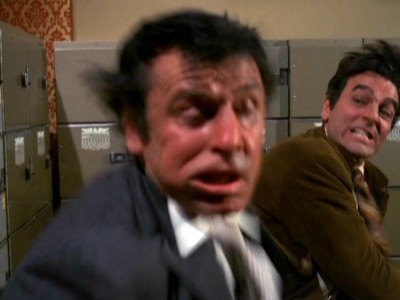
As I wrote in my previous review, for the uninitiated in the world of Joe Mannix, West Los Angeles private investigator, a brief run-down of Mannix's set-up is in order. Having dumped the chilly confines of the MCA-like Intertect Agency three years before for his own home base of operations, private detective Joe Mannix (Mike Connors) pads down the stairs from his second floor apartment/office at 17 Paseo Verde, and accepts the always-waiting first cup of coffee of the day from his pretty secretary, appropriately monikered, Peggy Fair (lovely, husky-voiced Gail Fisher). "Regular Joe" Mannix, operating with that easy air of a man who may have received one too many cracks to the skull, slips on his regulation sports coat or windbreaker, and calmly awaits his first beating of the day. In between assorted batteries on his person, Joe finds time to entertain clients in his Spanish-themed office, track down suspects in his sleek British racing green 1970 Plymouth Cuda 340 convertible, complete with handy telephone (not a CB, but a real phone, complete with a clunky handle receiver, telephone number KG6-21-14), make time with any number of gorgeous women, verbally spar with police Lieutenant Adam Tobias (Robert Reed, in an infrequent supporting role), and either beat or get beaten by apparently every known felon in the greater Los Angeles county area. Mannix always solves the case, and fees are only seldom paid. Oh, and if you need to contact Mannix, and he's not in his office, and his car phone isn't answering...try Los Angeles County Hospital.
SPOILERS ALERT
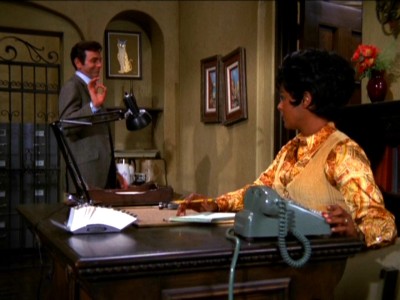
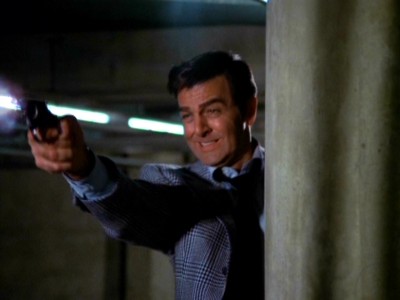
Re-reading my review for Season Three of Mannix, there is just no possible way for me to summon forth again that explosion of orgiastic love for the series in this fourth season review. I shot my bolt on that one when it comes to Joe Mannix. Before that third season set came, I hadn't seen Mannix for some twenty years or more, and like a long-lost old girlfriend you run into on the street...only to see her again, improbably, a week later, the first experience is overwhelming, while the second is, well...it's pretty good, too, come to think of it. This fourth season has more than its fair share of stand-out episodes (a handful are even series-best) and as I wrote in the third season review, there's an air of absolute cool, professional confidence to the production that makes every single one of its entries at the very least entertaining, with plot-dense mysteries that keep you guessing (no surprise there, considering the talent involved behind the scenes), and a deft, tough-guy, charming central performance by Mike "Touch" Connors that defines―in the very best sense of the phrase―"popular TV actor." As well, the supporting casts this season are chock-full of terrific, familiar faces from 60s and 70s movies and television, including Darren McGavin (ham-bone), Dane Clark, James B. Sikking, Jo Van Fleet, Jack Carter, David Sheiner, George Tobias, Brock Peters, Kim Hamilton, Juanita Moore, A. Martinez, Victor French, Loretta Switt, Hugh Beaumont, Rich Little (better at acting than imitating), Martine Beswick, Leslie Parrish, Don Dubbins, Hari Rhodes, Ford Rainey, Brad Dexter, Pat Quinn, Paul Carr (great as a weasel), Barry Atwater (of The Night Stalker fame), Ross Hagen, Warren Vanders, Michael Bell, Ward Wood, Larry Linville, Kim Hunter, Gloria Grahame (her upper lip now totally paralyzed), the terrific Katherine Justice, John Considine, Kate Woodville, Milton Selzer, J. Patrick O'Malley, Robert Lansing, Ruth Roman, James Wainwright, Woodrow Parfrey, Rosemary De Camp, Dewey Martin, Vincent Beck, Charles Bateman, Robert Hogan, Ellen Weston, Robert Webber (always great), Charles Aidman, Jason Evers, Marj Dusay, Alan Oppenheimer, the incomparable Diana Muldaur, Tiffany Bolling, John Colicos, Gail Goodrich, a certain...Lewis Alcindor, known later as Kareem-Abdul-Jabbar, Carol Lynley, Diane Keaton, John Vernon, Jan Murray, Paul Mantee, and the lovely Julie Gregg.
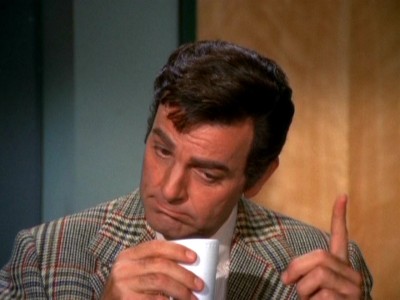
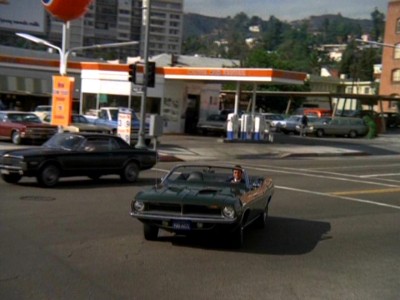
The opening episode, A Ticket To The Eclipse, perfectly sets the mood for the season to come, showcasing what I love about this series (and vintage 70s TV in general). One of Joe's old Korean War Army buddies, Darren McGavin, is a psychotic karate instructor (!) who, having served ten years for massacring civilians, is out for vengeance on Joe. McGavin hams it up just right, while there are several cool karate scenes inbetween moments of Joe wondering if McGavin's assertion is true: deep down, Joe's a killer, too (Joe also receives here his first of many bullet wounds to the arm this season, naturally). One For The Lady and Time Out Of Mind may play up Joe's faltering finances (a standard convention of the private dick genre), but fantasy is blissfully restored when nobody evicts him from his swank office/apartment, nobody repossesses his Cuda, and his faithful secretary Peggy laughs off not getting paid (One For The Lady is particularly enjoyable when you see where the rich, reclusive gangster moll Jo Van Fleet lives: the re-dressed interiors of Paramount's The Brady Bunch set!). Reworking another tried-and-true TV actioner plot, Figures In A Landscape can't miss when it goes out into the desert, stranding Joe and love interest Loretta Switt at the hands of killer Victor French (there's a solid scene of intrigue when Joe and Loretta engage in some Blow-Up action with a crucial photo negative).
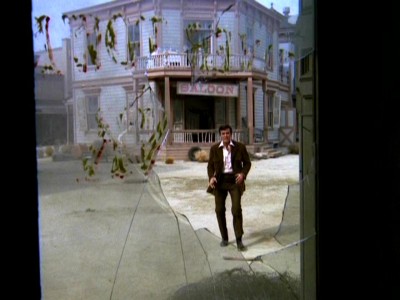
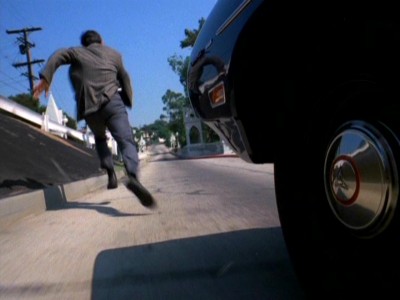
With Chester Krumholz' The Mouse That Died script referencing the noir classic, D.O.A., Mannix favorite, director Sutton Roley, has some fun visualizing poisoned Joe's hallucinations, including one I remember scaring the crap out of me when I was four: Joe encountering first devil worshippers...then his own corpse in a coffin, who jolts open his eyes to the screams of flipped-out Joe (at the story's end, when Peggy jokes, "Next time, stick to my coffee," Joe deadpans, "I'd rather be dead." Classic). The Lost Art of Dying may be highly improbable at its center―hardened death-row inmates would stage a prison riot to get Joe Mannix to come and investigate a case for an innocent kid???―but it's a nifty little "B" noir scripted by Ed Adamson and directed in a comic book, pulpy way by actor Fernando Lamas. Sunburst, with a script by vet Stephen Kandel, and clean, efficient direction by John Llewellyn Moxey, is a great mixture of The Petrified Forest, Bad Day at Black Rock, and the TV movie, Dying Room Only, in the kind of story from vintage TV that I crave (who out there reading this doesn't want once in their life to pull up to a lonely diner and fall into some kind of intrigue...as long as you don't get killed, that is?). Some amazing Joe Mannix antics here (watch Mr. Smooth immediately start dancing with the cowardly diner owner's slutty wife), including a sweet, dangerous-looking slide down a dam sluice, and Joe shooting dead the pilot of a plane that's taking off over his head...with his little snub-nosed .38 pea-shooter. He brushes off this feat as if he just kicked over a tin can (when the slutty wife cries over his cowardly loser-husband's death, perennial winner Joe Mannix shrugs casually and says, "He just had a dream he couldn't handle." Hee hee!).
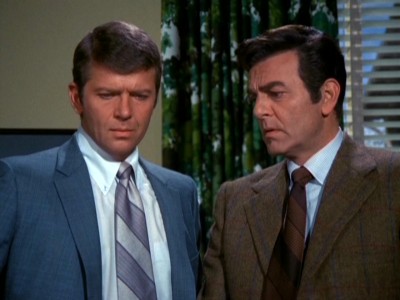
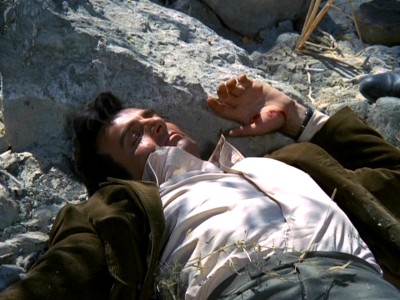
Speaking of amazing feats of Mannix-do, To Cage A Seagull not only has L.A. private detective Joe blowing up Nazis (I'm not kidding), but it also has him shoved down a twenty-foot deep stone cell, a tomb from which he escapes by using his trusty Timex® (you just knew he wore one of those) to carve out footholds in the mortar (his windbreaker? Not a crease). The Crime That Wasn't features Mannix's second kid client this year (was Hasbro® a new sponsor?), along with an absolutely insane supporting cast including Rosemary De Camp, Dewey Martin, Vincent Beck, Charles Bateman, Robert Hogan, and none other than (drum roll, please), Valley of the Dolls author, Jacqueline Susann (I almost dropped dead from excitement when she showed up―she's wonderfully awful here, by the way). A Gathering of Ghosts is another one of those plots that make me long for vintage TV: Joe's whacked-out college football team tricks him into coming to a surprise reunion at that ghost town where the Bradys were locked up by Mr. Howell. Not satisfied with that deception, they start to pull practical jokes about people dying...until real bodies start to pile up (god, TV was entertaining back then). Diane Keaton shows an early kooky take on Annie Hall in The Color Of Murder (she's in a whole other show when she breaks down at the end; you can see laid-back Connors startled by her intensity). And Shadow Play lays out a good "siege" episode―as well as an impromptu A Man Called Dagger reunion for Paul Mantee and Jan Murray―with pretty, talented Julie Gregg teaming up with Connors for a suspenseful actioner.
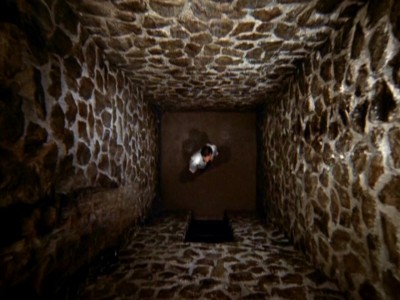
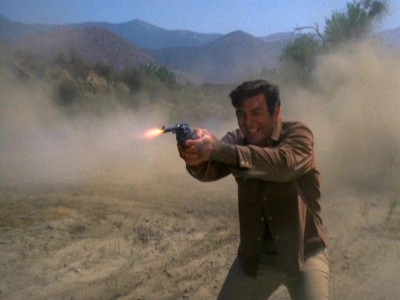
What Happened to Sunday? has what I consider the best visual summation of the entire series in the opening teaser: Joe frantically trying to elude not one but two muscle cars as they careen after him down a hilly, twisty L.A. street―a brilliant bit of almost surreal violence (Joe also gets to indulge in television's all-time favorite ailment here: amnesia, stumbling around in proper noir fashion as he tries to piece together his missing hours on a deadly case). However...the fun comes crashing down in Bang Bang You're Dead, an otherwise excellent little mystery that unfortunately punctures every TV fantasist's dream when Joe's little girl client, who's obsessed with TV mysteries and cops-n-robbers shows, experiences the terrors of real crime. Crying when she realizes she could have died, she tearfully looks up to Joe and sadly laments, "It's just not the same when it's real, is it?" to which Joe thoughtfully replies, "No...it's not the same." Sweet Jesus that's not what I want to hear in a Mannix episode.
This fourth season of Mannix would see a big leap in its Nielsen ratings, going from 30th the previous year, to a healthy 17th for this 1970-1971 season. After the purge of popular "rural" comedies at CBS (shows which still had many viewers...pity they were "too old" for the sponsors' liking), Mannix lost its three-year 9:30pm lead-in, Petticoat Junction (not a good match for this city actioner, anyway―it hadn't been in the Nielsen Top Thirty since 1966) for the epitome of this new CBS "urban" skew―The Mary Tyler Moore, which debuted to a sizeable 22nd ranking for the year. Facing stiff competition over on NBC―the last hour of The NBC Saturday Night Movie, which was 23rd for the year―Mannix increased its fan base, who followed it to Wednesday nights the following season, to spectacular results in the Nielsen's. Too bad CBS didn't just leave it there....
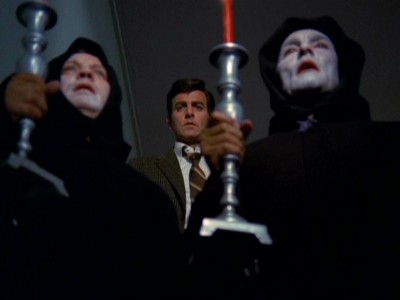
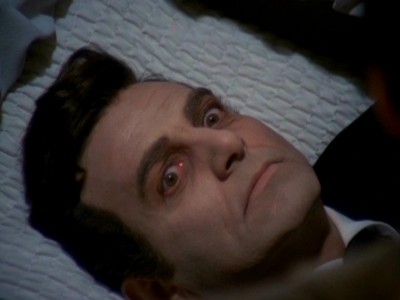
Here are the 24 episodes of the 6-disc set, Mannix: The Fourth Season, as described on the inside DVD slipcover:
DISC ONE
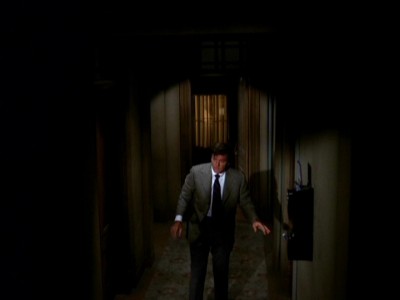
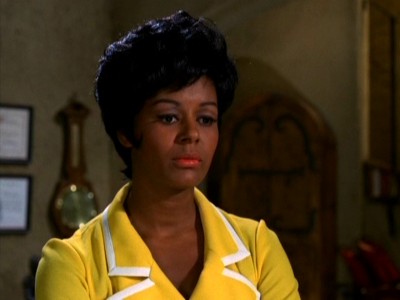
A Ticket To The Eclipse (September 9, 1970)
One of Joe's Korean War buddies is out for revenge and has already confessed to killing two men, but the police don't take him seriously.
One For The Lady (September 26, 1970)
After Mannix is framed and his private detective's license is suspended, he's forced to accept a job offer from a mysterious gangster's widow.
Time Out Of Mind (October 3, 1970)
When an ex-boxing champ is found standing over a gambler's dead body, Joe must track down the boxer before the dead man's gang gets to him.
Figures In A Landscape (October 10, 1970)
Plagued by crank phone calls, death threats, and an unknown stalker with a rifle, Mannix tries to stay alive long enough to find a missing woman.
DISC TWO
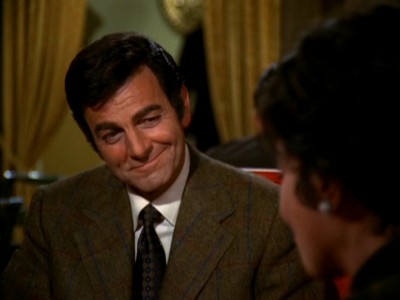
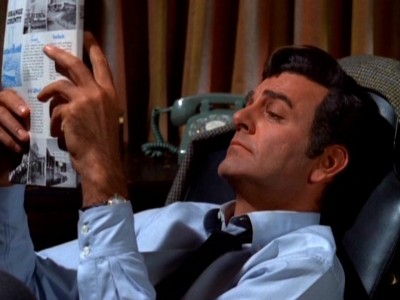
The Mouse That Died (October 17, 1970)
While investigating a missing persons case, Mannix uncovers an espionage ring. Later, he panics when he realizes he's been given a slow-acting poison.
The Lost Art of Dying (October 24, 1970)
Prisoners hold a guard hostage and demand that Mannix investigate the murder charge of a death-row inmate who is scheduled to die in 72 hours.
The Other Game in Town (October 31, 1970)
A gambler who owes $230,000 suddenly disappears, then reappears after his funeral. When his "widow" hires Mannix, Joe suspects insurance fraud.
The World Between (November 7, 1970)
While in the hospital for a work-related injury, Joe's secretary Peggy meets and falls for an African premier who is the target of an assassination plot.
DISC THREE
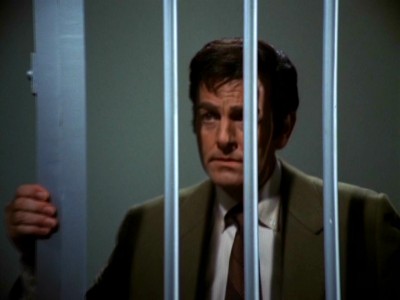
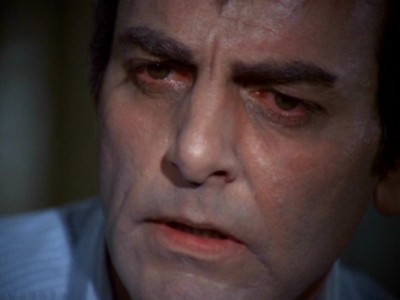
Sunburst (November 14, 1970)
Joe Mannix desperately tries to learn the true identities of the hoodlums who held him captive at a remote café out in the scorching desert.
To Cage A Seagull (November 21, 1970)
During Joe's routine investigation into a helicopter crash, two bizarre clues emerge, including the body of a former member of the Nazi party!
Bang, Bang, You're Dead (November 28, 1970)
After a hit-and-run attempt on a little girl, Mannix starts to believe her imaginary story about escaping from killers who may be plotting another murder.
Deja Vue (December 12, 1970)
A young female psychic predicts that Joe Mannix is going to die soon―and now it looks like her prediction is going to come true!
DISC FOUR
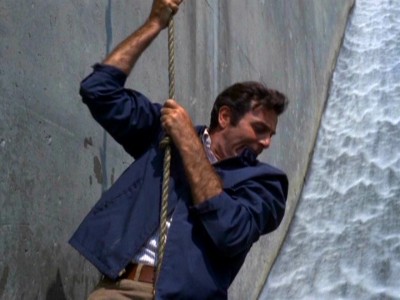
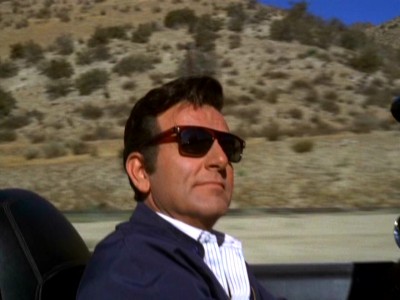
Duet For Three (December 19, 1970)
After a woman's husband commits suicide in Honk Kong, she is followed by a mysterious Vietnamese man―but Mannix can't figure out why.
Round Trip To Nowhere (January 1, 1971)
When Mannix is hired by a widow to find out who killed her husband, he becomes embroiled in a mystery and tries to figure out the dead man's secret world.
What Happened To Sunday? (January 9, 1971)
An injured Mannix can't remember what has happened to him in the past 24 hours, although his one vivid memory is that of a girl falling from a balcony.
The Judas Touch (January 16, 1971)
A police chief asks Mannix to help him find one of his police officers―an ex-convict who is suspected of committing robbery...and murder.
DISC FIVE
With Intent To Kill (January 23, 1971)
There has already been one attempt on a private detective's life. Now his wife is convinced that he will be killed, all due to his investigation into a robbery.
The Crime That Wasn't (January 30, 1971)
A missing body is a key element in a syndicate hit put out on Joe Mannix, as a young boy fears for his life, as well as the lives of his parents.
A Gathering of Ghosts (February 6, 1971)
Joe's college football team reunion is pretty unconventional. It's held in a ghost town, but then turns sinister and ultimately deadly when a murder occurs.
A Day Filled With Shadows (February 13, 1971)
A kidnapping is linked to a gangland murder as Mannix races against some syndicate enforcers to find a basketball star, the son of a millionaire.
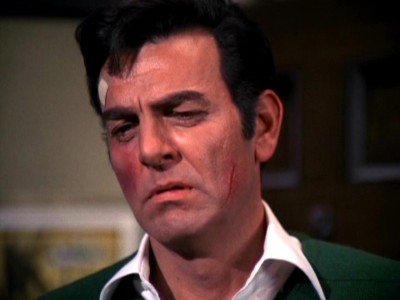
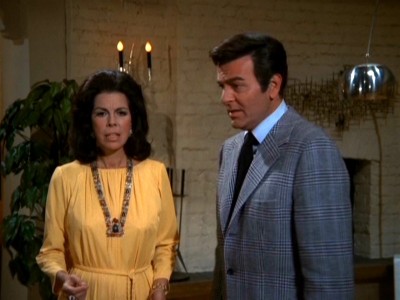
DISC SIX
Voice In The Dark (February 20, 1971)
A former diving champion who is disabled claims she has been getting death threats, but needs Joe's help to prove that it's really happening to her.
The Color Of Money (February 27, 1971)
Mannix has been given the daunting task of trying to piece together the case of a man who was killed just as he was about to testify against a crime boss.
Shadow Play (March 6, 1971)
Joe takes on the case of a mob financier's wife who died in a hit-and-run accident. The suspect? Her husband.
Overkill (March 13, 1971)
A case takes an unexpected twist when Joe discovers that the psychotic who may have killed the private eye's friend wasn't responsible for all his alleged crimes.
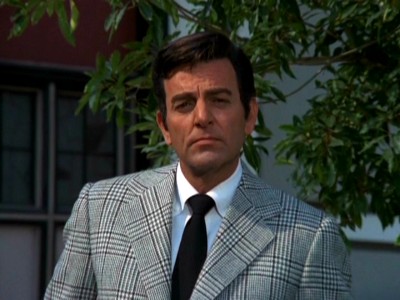
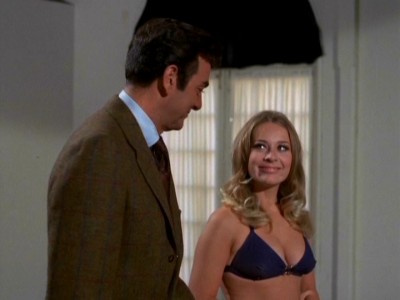
The DVD:
The Video:
A solid presentation. The full-screen, 1.33:1 transfers look quite good, with saturated colors (a few scenes here and there looked a little washed out, but they were isolated), with minimal grain and a sharpish picture. A typical Paramount vintage television release (i.e.: quite good in the video department).
The Audio:
The Dolby Digital English mono audio track is big and fat, and all dialogue is clearly heard. English subtitles are available.
The Extras:
No extras for this release (come on―shoot a few bucks to "Touch" and lets get him back for some commentaries!).
Final Thoughts:
Another smashing season from one of the top ten detective series in the history of television. Great, pulpy noirish mysteries, terrific supporting casts, a big-screen polish to the production, and Mr. Mike Connors himself as the almost Bondian private dick who's an Armenian sex machine to all the chicks. I'm ordering my Botany 500® golf cardigans right now. I'm highly, highly recommending Mannix: The Fourth Season.
Paul Mavis is an internationally published film and television historian, a member of the Online Film Critics Society, and the author of The Espionage Filmography.
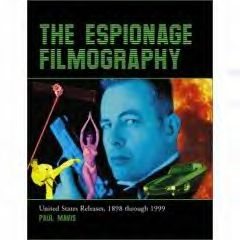

|
| Popular Reviews |
| Sponsored Links |
|
|
| Sponsored Links |
|
|
| Release List | Reviews | Shop | Newsletter | Forum | DVD Giveaways | Blu-Ray | Advertise |
|
Copyright 2024 DVDTalk.com All Rights Reserved. Legal Info, Privacy Policy, Terms of Use,
Manage Preferences,
Your Privacy Choices | |||||||














